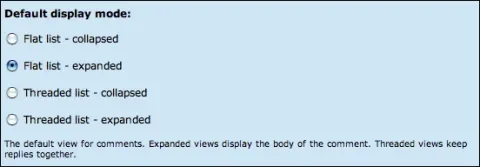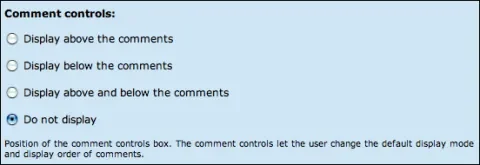Drupal offers many different settings for displaying and collecting comments. Listings can be displayed in forward or reverse chronological order, and comments can be displayed in a tree-like hierarchy so that it is possible for people follow the thread as users comment on comments.
However from a usability standpoint, most of these options are NOT GOOD.
In this article, I'm going to run through the various Drupal comment options and the pros and cons of each setting.
Viewing Options
Display Mode
Collapsed vs. Expanded
From the "I Don't Know Why Drupal Even Has This Option" department comes the "collapsed" option which breaks every comment out onto its own page. This makes it virtually impossible to follow series of comments because reading each requires clicking on its title in the list, reading it, hitting the back button, and scrolling down to try to find your place in the comment listing. Does anyone use this? Use expanded.
Threaded Lists
While this option looks useful on its surface, in use it means that comments will no longer be listed in chronological order. By placing listings in a threaded list, comments are listed by thread before they are listed by date. So the latest posts will not necessarily be at the bottom of the page. In addition, many users don't understand the concept of the threaded comments and will click on any "reply" link splitting off a thread when they really mean to respond to the original post. Keep in mind that you want the users to post ON THE TOPIC OF YOUR POST and NOT to wander off onto tangental subjects. You want comments on any given node to be ABOUT THAT NODE. If the subject of a discussion changes, it should move elsewhere. People will not come to an entry entitled "Drupal Comment Usability" to find discussion about configuring clean urls - so your user interface should discourage this type of tangental commenting.
Display Order
While it is the convention of blogs to show the latest blog entries at the top of the page, do not get confused and believe that comments should be handled the same way. Most visitors to a web page will expect that they will be able to follow the history of a page by reading from top to bottom. This means that the latest comments should be listed at the bottom therefore comments should be listed oldest first.
Comment Controls
By enabling comment controls, it is possible to allow the users to configure any of the above settings themselves - essentially destroying any comment configuration that the administrator has done. I'm from the school of: "Give the options to the administrators, NOT to the users". It will be the novice users who arrange their settings so that they can no longer follow the comments. They will call you on the phone asking what has happened to your site. I recommend setting comment controls to "do not display".
Comments Per Page
While shorter pages are generally more usable, setting the number of comments per page to a low number comes in conflict with my recommendation of setting the display order to oldest first. With a small number, it is very possible that the latest comments will not be listed on the initial page and will require several clicks and scrolling to get to them. This is bad. A better solution is to set the comments per page as high as possible. Users will intuitively scroll down to find the latest stuff.
Posting Settings
Anonymous Commenting
Anonymous commenting is good. Most users will not want to register for a site simply to post a comment. However allowing random comments opens up a site to comment spam. These comments are placed on sites across the net in order to link people to a commercial (usually gambling or porn) site and also to increase the site's Google ranking.
A solution to this problem is to visit admin/access and set permissions so that anonymous users can post comments, but their comments will require approval. Then either visit admin/comment/list/approval on a regular basis to see if there are new comments or use a solution like Comment Mail module or Actions and Workflow (untested) to have email sent to the site administrator when new comments (requiring approval) are posted to the site.
Contact information for anonymous users can be optional, required, or not collected at all. I prefer the optional option so that users can post to the site anonymously or give themselves credit if they choose.
Anonymous commenting is enabled on the "administer >> access" page in Drupal.
Other Comment Options
Subject Field: Technically speaking the subject of most comments will be the post itself. So the comment subject line often ends up being something like, "Agreed" or "Another thought", which doesn't really mean much. However the comment subject line is used in the comment block and several other places in Drupal where comments are listed. If it is not enabled, Drupal will use the first few words of the post as the subject line. It's a close call on this one, but I'm going to recommend leaving it enabled.
Preview Comment: Requiring comments to be "previewed" before posting provides another line of defense against comment spam. And since anonymous users will not be able to edit their comments once they are posted to the site, it is also a last chance to review their post before it is committed. However, from a usability standpoint, the idea of adding an extra screen to the posting process is confusing. Many users will get to the preview screen and assume that since they are seeing their comment presented on the screen, the comment has been posted to the site. They could navigate away and never have their comments actually posted.
My recommendation: If you're site has primarily registered users, do not require preview. If you're site has primarily anonymous (non-logged-in) users, do require preview.
Location of Comment Form: This one really depends on the design esthetic of your site. You can choose to place the comment form at the bottom of the comments on the post page, or on a separate page. From a usability standpoint it is clearer to a user that they CAN post a comment if there is a form presented right there at the bottom of the comments. It really comes down to how hard you want to push for comments to your posts. So basically, if it doesn't turn your designer's stomach, place the comment form at the bottom of the post page.








